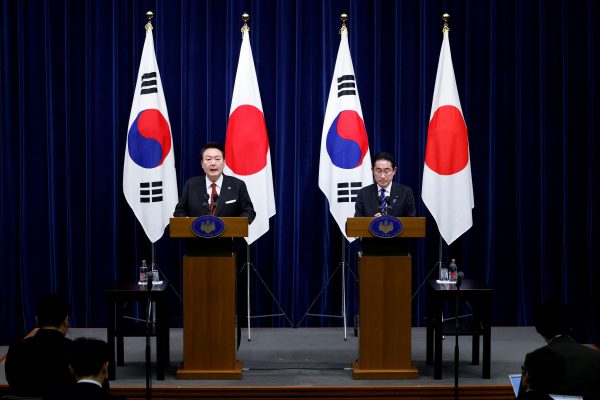The biggest points of contention are the issues of compensation for Korean labourers forced to work for Japanese companies and ‘comfort women’ forced to provide sexual services to Japanese soldiers during the Second World War. Japan’s official position is that the 1965 Basic Treaty normalising relations settled all issues between the two countries during the colonial period. South Koreans consider that the 1965 agreement did not adequately address the comfort women and forced labour issues.
As part of that normalisation deal, Japan provided South Korea with economic cooperation (US$300 million in grants, US$200 million in soft government loans and US$300 million in private loans from Japanese banks). But the South Korean government used that money mostly for economic development projects rather than to compensate individual victims. After South Korea democratised in 1987, new political space began to open, enabling the forced labourers and comfort women to be heard.
While Japan maintains that it has met its legal obligations, it decided to treat the comfort women issue as a special case from a moral perspective. It established the Asian Women’s Fund (1995–2007), which provided compensation to the comfort women from donations solicited from the Japanese public as well as contributions from the Japanese government for specific projects such as medical care. Under a 2015 comfort women agreement, the South Korean government established a foundation to support the comfort women, and the Japanese government made a one-time contribution to ‘finally and irreversibly’ resolve the issue.
Unfortunately, these initiatives divided the former comfort women. Some accepted the payments. Others rejected them on the grounds that the Japanese state was avoiding its legal responsibility and should pay direct compensation, wanting an explicit legally-based admission of guilt and an apology beyond that made in the 1993 Kono Statement. So unpopular was the 2015 comfort women deal in South Korea that the Moon government disbanded the foundation, which effectively terminated the agreement.
Comfort women who rejected compensation and forced labourers have spent years seeking justice through the courts. Their efforts have resulted in a series of inconsistent rulings in South Korean courts, including a landmark judgement in the South Korea Supreme Court in 2018 ordering Mitsubishi Heavy Industries and Nippon Steel to provide compensation to a handful of surviving victims of forced labour. But since Japan maintains its position that it has met its legal responsibilities and argues that such rulings are a violation of international law and the 1965 treaty, the situation remained at an impasse.
In 2019, relations hit their lowest point since normalisation when Japan imposed export restrictions on key chemicals used in manufacturing semiconductors and smartphone screens to South Korea. Japan claimed that South Korea was failing to exercise appropriate controls on the re-export of the chemicals, which have dual military applications, to third countries such as North Korea, but the move was politicised by former prime minister Shinzo Abe and seen as retaliation for the South Korean court rulings against Japanese companies. The Moon government then threatened to pull out of the Japan–ROK General Security of Military Information Agreement, a key mechanism for sharing intelligence about North Korea and its missile and nuclear threats.
Against this background, the Yoon government moved boldly to try and resolve the stalemate. It set up private consultations with the forced labour victims and conducted a public consultative process to sound out the idea of a fund drawing on voluntary private contributions, including from South Korean firms that benefited from Japan’s economic cooperation funding, such as steelmaker POSCO. It then showed the results of these consultations to the Japanese government and underlined the importance of Japanese companies reciprocating with their own ‘voluntary’ contributions and apology for the deal to gain acceptance from the victims and the South Korean public.
As Daniel Sneider explains in this week’s lead article, although Kishida has so far failed to find a way for Japan to reciprocate, Yoon’s gambit ‘cleared away much of the accumulated debris of the last five years of dysfunctionality [in the relationship]’. The Yoon-Kishida summit ‘checked off a substantial list of to-do items. It restored regular meetings between the leaders of the two countries and rolled back the tit-for-tat trade measures in place since 2019. The two leaders embraced a shared security agenda, topped by countering North Korea, and reaffirmed the operation of the General Security of Military Information Agreement intelligence-sharing pact’.
This is welcome news to the Biden administration in the United States. Since taking office, it has relentlessly urged the need for deeper US–Japan–ROK trilateral security cooperation. But loud US support cheering on the Kishida–Yoon summit may be premature. Polls in South Korea show that 59 per cent of the public oppose Yoon’s plan to compensate the forced labourers from an exclusively South Korean fund — they want compensation directly from Japan.
The question now is whether and how Kishida might find a way for Japan to reciprocate and build a basis for a more long-term and sustainable rapprochement that receives public and elite acceptance in both countries without relying on behind-the-scenes pressure from the United States.
These hurdles that Kishida faces will take some effort to overcome. As Sneider says, Kishida appears to be ‘wary of bilateral agreements on history issues due to the controversies which arose from the 2015 compensation and apology deal for South Korean “comfort women” he reached as foreign minister’. Kishida is also bound by the delicate balance of factional politics in the ruling Liberal Democratic Party, dominated by conservative nationalist factions such as the Seiwakai which are overrun by historical revisionism and denialism.
While Yoon’s decisive moves to foster cooperation have opened ‘the door to rapprochement and normalisation of South Korea–Japan relations … the perils of reversal remain’. Hopes now hang on a visit by Kishida to Seoul later this year to seize the day.
The EAF Editorial Board is located in the Crawford School of Public Policy, College of Asia and the Pacific, The Australian National University.

